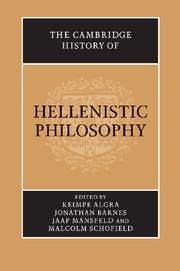Book contents
- Frontmatter
- PART I INTRODUCTION
- 1 Sources
- 2 Chronology
- 3 Organization and structure of the philosophical schools
- PART II LOGIC AND LANGUAGE
- PART III EPISTEMOLOGY
- PART IV PHYSICS AND METAPHYSICS
- PART V ETHICS AND POLITICS
- Synopsis of principal events
- Editions of sources and fragments
- List of abbreviations
- Bibliography
- Index locorum
- General Index
- References
3 - Organization and structure of the philosophical schools
from PART I - INTRODUCTION
Published online by Cambridge University Press: 28 March 2008
- Frontmatter
- PART I INTRODUCTION
- 1 Sources
- 2 Chronology
- 3 Organization and structure of the philosophical schools
- PART II LOGIC AND LANGUAGE
- PART III EPISTEMOLOGY
- PART IV PHYSICS AND METAPHYSICS
- PART V ETHICS AND POLITICS
- Synopsis of principal events
- Editions of sources and fragments
- List of abbreviations
- Bibliography
- Index locorum
- General Index
- References
Summary
Before tackling in detail the issue of the organization and structure of the philosophical schools, both in the Hellenistic period and more generally, one must try to find an answer to the question of what a philosophical school was. This is a difficult question, which has not yet found an answer that copes satisfactorily with all the problems it poses.
Until recently the theory of Wilamowitz prevailed, according to which the philosophers' schools were religious societies (thiasoi), dedicated to the worship of the gods, or the Muses in this particular case. Wilamowitz started from the presumption that all such ancient societies had cult characteristics and that, for this reason, they were recognized by Athenian law, giving them the status of legal bodies. From an outsider's viewpoint the philosophical schools would therefore have appeared to be religious societies devoted to the worship of the Muses, while internally they would have developed functions like those of modern universities. In the Academy and Peripatos, above all, there would have been activity in scientific research and teaching based on a division of duties between teachers old and young, and carried out in a series of public lectures and private seminars.
Wilamowitz's theory has attracted criticism and objections. In particular, it has been discovered that certain elements which for Wilamowitz were typical of a thiasos (statues of the Muses and their worship) were shared by other institutions like the gymnasia and children's schools, and were therefore not by themselves enough to support the identification of philosophical schools as religious societies.
- Type
- Chapter
- Information
- The Cambridge History of Hellenistic Philosophy , pp. 55 - 62Publisher: Cambridge University PressPrint publication year: 1999
References
- 9
- Cited by

